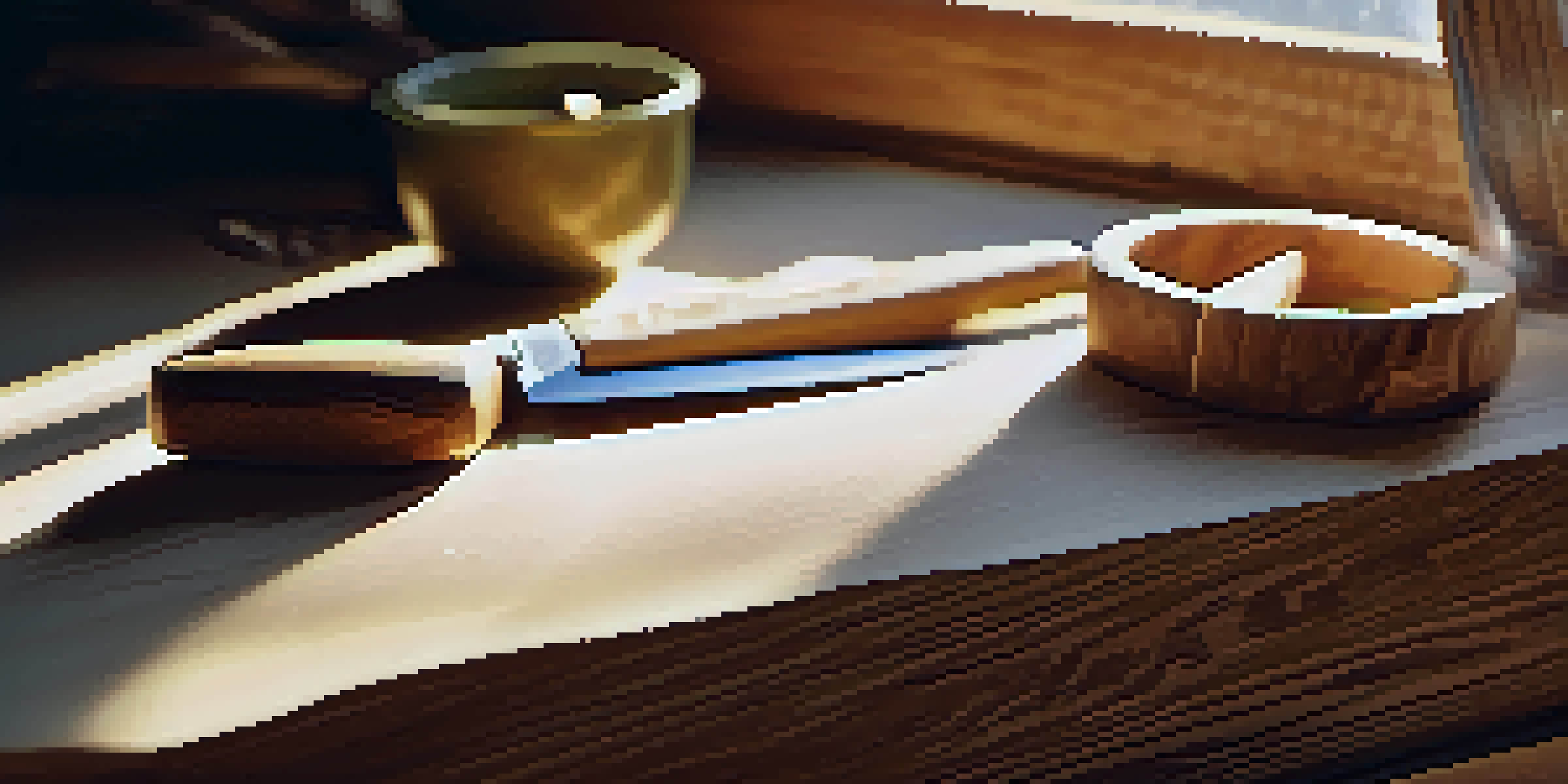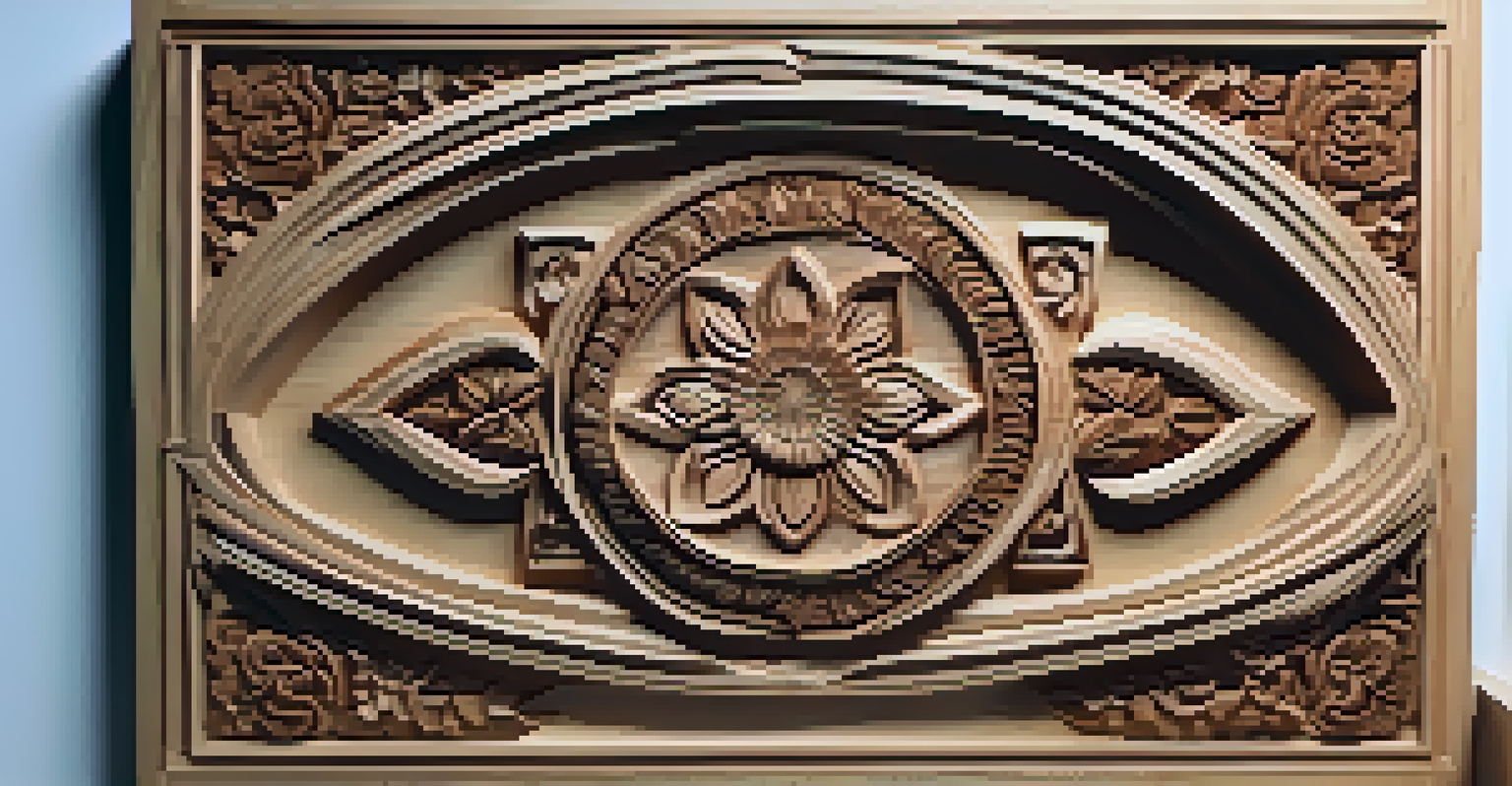Techniques Unique to Wood Carving: A Deep Dive

The Art of Whittling: A Beginner's Approach
Whittling is one of the most accessible forms of wood carving, perfect for beginners. It involves using a simple knife to shape wood, often from a single piece of material. This technique encourages creativity, as you can easily turn a block of wood into a recognizable form with just a few cuts.
The wood is a canvas, and the carver is the artist who brings it to life.
The beauty of whittling lies in its simplicity; you don’t need fancy tools or extensive training to start. All you need is a sturdy piece of wood and a sharp knife, making it an affordable hobby. As you practice, you’ll find that your skills improve, allowing you to create more intricate designs.
Moreover, whittling can be meditative. Many enthusiasts find joy in the repetitive motions and the satisfaction of watching their piece take shape. So, if you're looking for a stress-relieving activity, grab a knife and a piece of wood, and start whittling!
Understanding Relief Carving Techniques
Relief carving is a unique technique that creates a three-dimensional effect on a flat surface. This form of carving involves removing the background wood to make the design stand out, almost like a raised image. It’s often used in decorative art and can be found in furniture, architectural elements, and signage.

There are various levels of relief carving, ranging from low relief, where the image slightly protrudes, to high relief, which can be very pronounced. Each level requires different tools and techniques, making it a versatile skill for woodworkers. With practice, you can master the nuances of this technique to bring your artistic visions to life.
Whittling: Simple and Accessible
Whittling is an easy entry point into wood carving, requiring only a knife and a piece of wood for creativity and relaxation.
One of the most rewarding aspects of relief carving is the ability to create depth and texture. By playing with light and shadow, you can give your work a dynamic quality that draws the viewer in. This technique not only enhances visual appeal but also showcases the intricacies of the wood grain itself.
Chip Carving: Precision and Pattern
Chip carving is a distinctive technique known for its intricate geometric patterns and sharp angles. This method involves removing small chips of wood with a specialized knife, resulting in stunning designs that often resemble lace. It's a technique rooted in tradition, often seen in folk art from various cultures.
Every piece of wood has a story to tell, and it's the carver's job to listen.
What sets chip carving apart is its focus on precision. Each cut must be deliberate, as mistakes can be challenging to correct. However, the reward is a beautifully detailed piece that showcases your skill and creativity. As you gain confidence, you can experiment with more complex patterns and even incorporate color into your designs.
This technique also encourages a strong connection between the artist and the material. By focusing on these small details, you learn to appreciate the unique characteristics of the wood. Chip carving isn't just about creating art; it’s about developing a deeper understanding of the medium you’re working with.
Power Carving: Harnessing Modern Tools
Power carving is a modern technique that utilizes electric tools, allowing for more significant detail and speed in the carving process. With tools like rotary carvers and angle grinders, artists can achieve intricate designs that would take much longer using traditional methods. This technique is particularly popular among advanced carvers looking to push the boundaries of their creativity.
While power carving can seem intimidating at first, it offers a level of control that can lead to stunning results. The key is to start slowly and practice, as mastering the tools can take time. As you become comfortable, you’ll find that power carving opens up new possibilities for your projects.
Relief Carving Adds Depth
Relief carving creates a three-dimensional effect by removing background wood, allowing for intricate designs that enhance visual appeal.
Many woodworkers appreciate how power carving can save time without sacrificing quality. It allows for experimentation with textures and forms that might be difficult to achieve manually. As you explore this technique, you'll discover a whole new world of wood carving possibilities.
The Beauty of Inlay Techniques in Wood Carving
Inlay techniques involve embedding contrasting materials into the wood to create stunning designs. This can include materials like metal, stone, or other types of wood, adding depth and visual interest to your projects. Inlays can be used to enhance carvings or create standalone pieces that showcase your craftsmanship.
One of the most appealing aspects of inlay work is the endless design possibilities. Whether you’re looking to add a simple border or create a complex scene, inlays can elevate your wood carving to a new level. The process requires patience and precision, making it a rewarding challenge for those who enjoy detail-oriented work.
As you explore inlay techniques, you'll appreciate the fusion of different materials and textures. This method encourages creativity and innovation, allowing your personality to shine through your work. Ultimately, inlay techniques can transform a basic carving into a unique piece of art.
Carving with Nature: Incorporating Natural Elements
Incorporating natural elements into your wood carving can add a unique touch to your work. This technique involves using the natural contours and imperfections of the wood to enhance your design. By embracing the wood's natural state, you can create pieces that tell a story and reflect the beauty of nature.
For instance, gnarled branches or knots in the wood can serve as focal points in your carving. Instead of hiding these features, you can highlight them, making your work more organic and interesting. This approach not only showcases your creativity but also honors the material you’re working with.
Inlay Techniques for Unique Art
Inlay techniques involve embedding different materials into wood, offering endless design possibilities and elevating the craftsmanship of your work.
Many woodworkers find that working with natural elements leads to unexpected and delightful outcomes. It encourages a sense of spontaneity, allowing your artistic vision to evolve as you carve. By blending your creativity with nature's imperfections, you can create truly one-of-a-kind pieces.
Finishing Techniques: The Final Touches
Finishing techniques are crucial in wood carving, as they protect your work and enhance its beauty. Different finishes, like oils, stains, and varnishes, can dramatically change the appearance of your piece, highlighting the wood grain and adding depth. Choosing the right finish depends on the desired look and the type of wood you're using.
Applying a finish is not just about aesthetics; it also helps preserve your work from damage caused by moisture and wear. A well-finished piece can last for generations, becoming a cherished heirloom. This step is often what separates amateur work from professional craftsmanship.

Moreover, experimenting with finishes can be an exciting part of the creative process. You might find that a particular finish brings out qualities in your wood that you hadn’t noticed before. By paying attention to this final step, you ensure your art is not only beautiful but also durable.